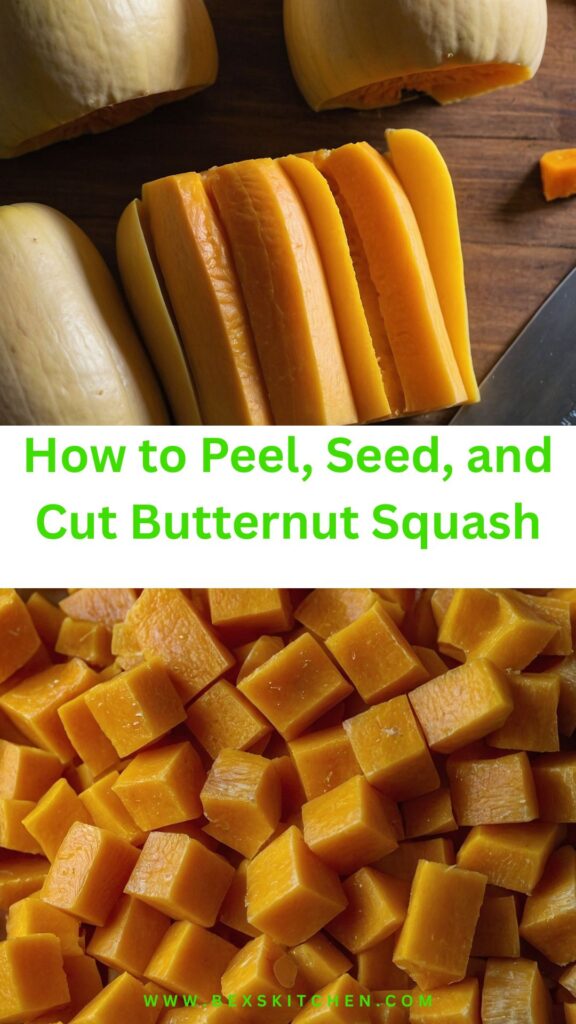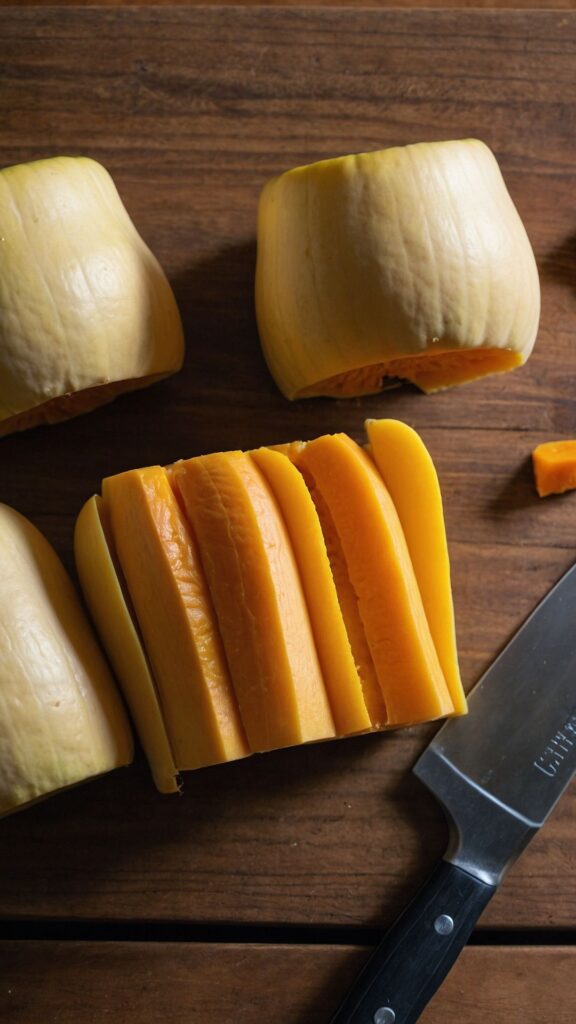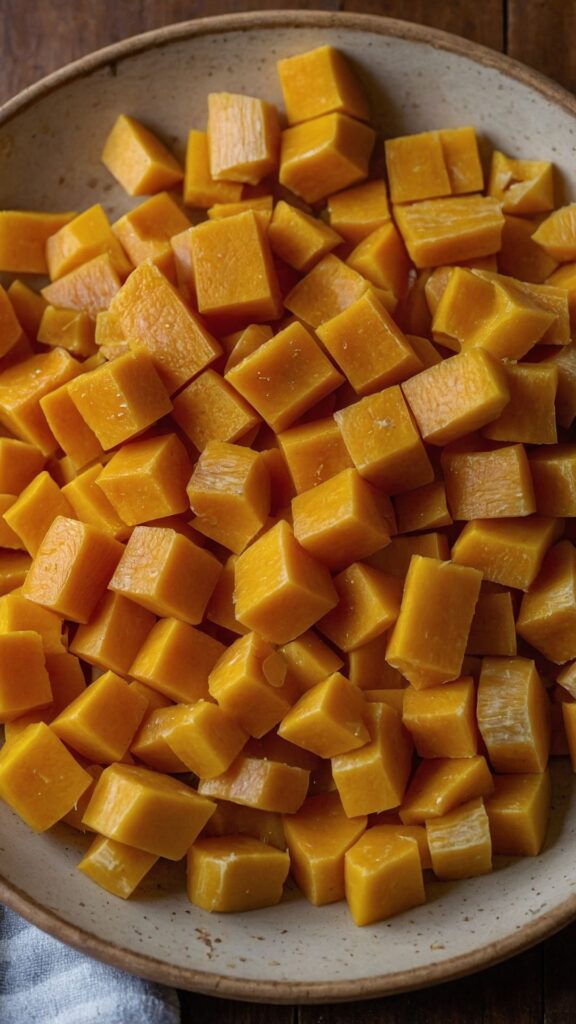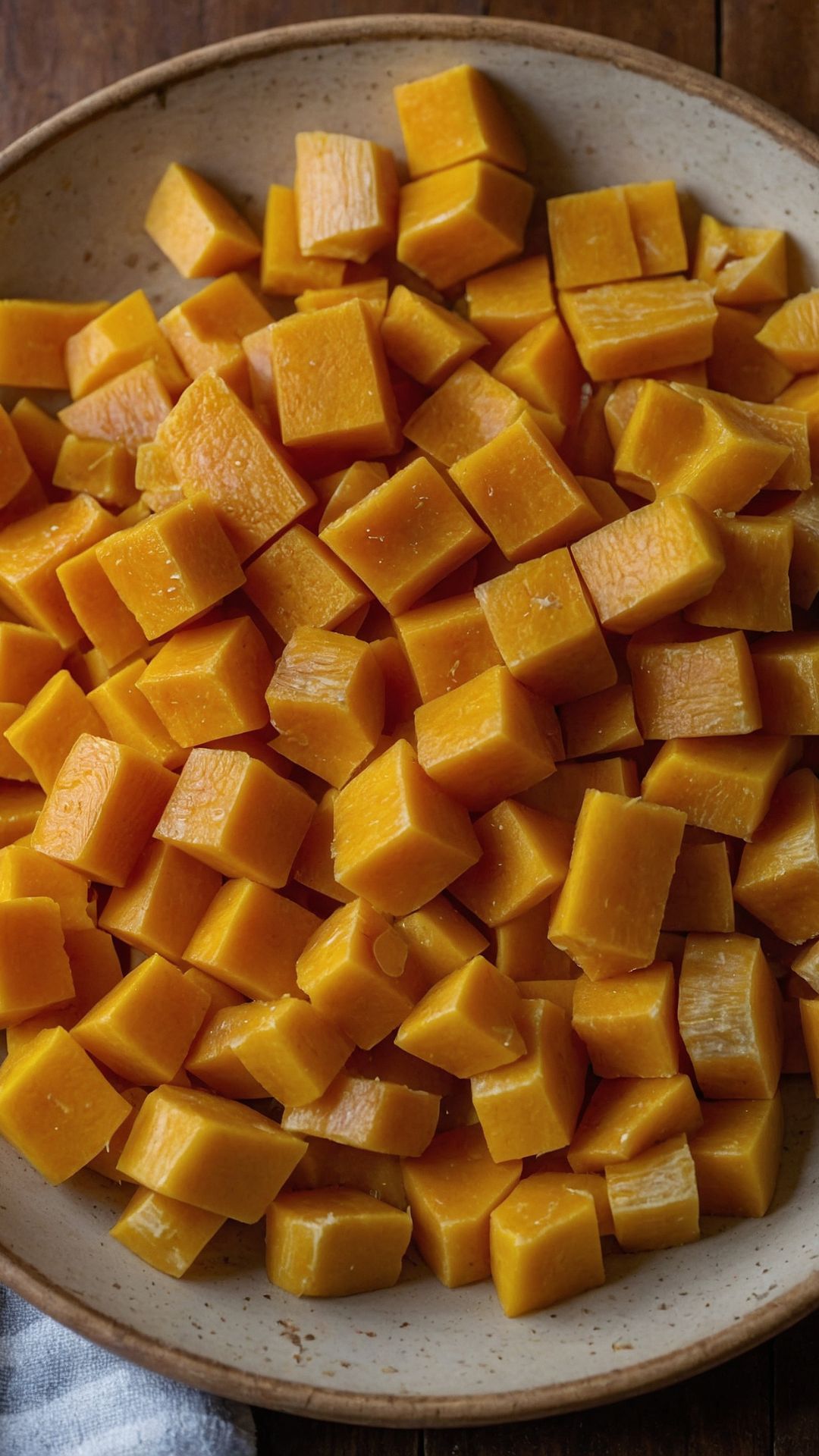As a devoted food enthusiast, I cherish the vibrant flavors and versatility of seasonal produce. Recently, I fell head over heels for butternut squash. Its sweet, nutty flavor pairs wonderfully with many dishes, especially in hearty soups and creamy risottos. Imagine standing in your kitchen, a cozy pot of roasted butternut squash soup simmering on the stove, filling your space with warmth and inviting aromas. That’s the kind of magic butternut squash brings to a meal.
In this guide, I’ll share everything you need to know about peeling, seeding, and cutting butternut squash. Together, we’ll explore not only the how-to but also some tips and tricks to make the process smoother and more enjoyable!

What is Butternut Squash?
Butternut squash is a type of winter squash that resembles a bulbous pear. This squash is not just aesthetically pleasing; its orange flesh is packed with vitamins A and C, fiber, and antioxidants, making it a nutritious choice. It has a sweet, nutty flavor that enhances both savory and sweet preparations. Whether you opt for roasting or pureeing, butternut squash is truly a kitchen superstar.
You will also like the following Side Dishes recipes!
The Ingredients
To start, you only need one ingredient:
- 1 butternut squash
That’s it! Simple, isn’t it? However, remember that the method matters, and we’ll need the right tools to make things easier.

How to Peel, Seed, and Cut Butternut Squash?
Before we dive into step-by-step guidance, a brief overview: Peeling, seeding, and cutting butternut squash requires a bit of patience and the right technique. The skin is tough, but with the right tools and process, you’ll have perfectly cut pieces ready for cooking.
Step 1: Gather Your Tools
Let’s start by gathering what we need.
- A sharp vegetable peeler: One that feels comfortable in your hand.
- A sturdy chef’s knife: This is vital for cutting through the tough skin.
- A large cutting board: To provide a stable surface.
- A spoon: For scooping, particularly for seeding.
- A towel: Optional. It can keep the cutting board steady.
Step 2: Wash and Trim
First, wash the butternut squash under cold water to remove any dirt and pesticides. Once clean, use a chef’s knife to cut off both ends of the squash. This gives you a flat surface to stabilize it while peeling and cutting.
Step 3: Peel the Squash
Using the vegetable peeler, start from the top and work your way down. Apply firm pressure, but be careful—those peeler blades can be sharp! If you find it tough, I’ve found that if you peel just two or three strips and then rotate the squash, it can be easier.
Step 4: Cut the Squash in Half
Position the squash upright on your cutting board. Carefully use the chef’s knife to slice it down the middle lengthwise. It may take some elbow grease, so go slow and steady.
Step 5: Remove the Seeds
Using a spoon, scrape out the seeds and fibrous strands from each half. That flesh is perfect for roasting, so try not to waste any!
Step 6: Cut into Desired Shapes
Finally, place each half flat-side down on the cutting board for stability. From here, you can slice it into cubes, wedges, or whatever shape your recipe calls for. I recommend cutting the squash into half-inch slices for even cooking time.
Step 7: Prepare for Cooking
Once you have everything cut, you can toss it in olive oil, season with salt and pepper, and roast at 400°F for about 25-30 minutes until golden brown and tender.
Notes (Tips for Success)
Here are some additional tips to simplify the process:
- Microwave for 2-3 minutes: Before peeling, microwave the squash for a couple of minutes to soften it slightly.
- Use a good-quality knife: A sharp knife not only ensures safety but also makes cutting easier.
- Save the seeds: You can actually toast the seeds! Just rinse, season, and bake for a crunchy snack.
- Oil your hands: Rubbing a bit of olive oil on your hands can help grip the squash better when peeling.
- Practice makes perfect: If you’re new to this, don’t worry. The more you do it, the easier it will become.
Storage Tips
If you have leftover butternut squash, store it in an airtight container in the fridge. It’s best used within 3-5 days. For long-term storage, consider freezing the prepared squash. Lay out the pieces in a single layer on a baking sheet, freeze until solid, and then transfer to a freezer bag. This way, you can have squash ready for soups or purees anytime!
Nutrition Information
Butternut squash is a powerhouse. A typical serving (about one cup) has roughly:
- Calories: 82
- Carbohydrates: 22g
- Fiber: 6g
- Sugar: 4g
- Protein: 2g
- Fat: 0g
It’s low in calories and an excellent source of vitamins. Incorporating it into meals supports overall health and wellness.

Serving Suggestions
Here are some delicious ideas to serve your prepared butternut squash:
- Roasted as a side dish: Toss with olive oil, garlic, and rosemary before roasting. Serve alongside a protein for a balanced meal.
- In soups: Blend the roasted squash with vegetable broth, ginger, and a splash of cream for a warm soup that’s perfect for chilly evenings.
- In salads: Toss cubes of roasted butternut squash in a fall salad with kale, cranberries, and feta for a colorful and nutritious meal.
- Pasta dish: Combine with whole-grain pasta, sautéed spinach, and a light Alfredo sauce for a comforting pasta dish that highlights the squash’s sweetness.
- As a puree: Use butternut squash puree as a child-friendly option mixed with pasta or in baked goods for extra moisture.
What Other Substitutes Can I Use?
If butternut squash is not available, consider these vegetables:
- Acorn squash: Similar texture and sweetness. Cut and prepare in the same manner, but cooking times may differ slightly due to size.
- Pumpkin: Another winter squash option, with a slightly different flavor. Also great in soups and purees.
- Sweet potatoes: These provide a sweeter flavor, and you can substitute in equal amounts.
- Carrots: They’re crunchier and sweeter. You may want to cook them longer for a similar texture.
- Parsnips: With their earthy flavor, parsnips can bring uniqueness to your dishes. They’ll require additional seasoning due to their distinct taste.

Equipment
- knife
Ingredients
- 1 butternut squash
Instructions
Step 1: Gather Your Tools
- Let’s start by gathering what we need.
- A sharp vegetable peeler: One that feels comfortable in your hand.
- A sturdy chef’s knife: This is vital for cutting through the tough skin.
- A large cutting board: To provide a stable surface.
- A spoon: For scooping, particularly for seeding.
- A towel: Optional. It can keep the cutting board steady.
Step 2: Wash and Trim
- First, wash the butternut squash under cold water to remove any dirt and pesticides. Once clean, use a chef’s knife to cut off both ends of the squash. This gives you a flat surface to stabilize it while peeling and cutting.
Step 3: Peel the Squash
- Using the vegetable peeler, start from the top and work your way down. Apply firm pressure, but be careful—those peeler blades can be sharp! If you find it tough, I’ve found that if you peel just two or three strips and then rotate the squash, it can be easier.
Step 4: Cut the Squash in Half
- Position the squash upright on your cutting board. Carefully use the chef’s knife to slice it down the middle lengthwise. It may take some elbow grease, so go slow and steady.
Step 5: Remove the Seeds
- Using a spoon, scrape out the seeds and fibrous strands from each half. That flesh is perfect for roasting, so try not to waste any!
Step 6: Cut into Desired Shapes
- Finally, place each half flat-side down on the cutting board for stability. From here, you can slice it into cubes, wedges, or whatever shape your recipe calls for. I recommend cutting the squash into half-inch slices for even cooking time.
Step 7: Prepare for Cooking
- Once you have everything cut, you can toss it in olive oil, season with salt and pepper, and roast at 400°F for about 25-30 minutes until golden brown and tender.
Notes
- Microwave for 2-3 minutes: Before peeling, microwave the squash for a couple of minutes to soften it slightly.
- Use a good-quality knife: A sharp knife not only ensures safety but also makes cutting easier.
- Save the seeds: You can actually toast the seeds! Just rinse, season, and bake for a crunchy snack.
- Oil your hands: Rubbing a bit of olive oil on your hands can help grip the squash better when peeling.
- Practice makes perfect: If you’re new to this, don’t worry. The more you do it, the easier it will become.
Nutrition
FAQs
1. Can I eat the skin of butternut squash?
While the skin is technically edible, it’s tough and not very palatable. Most recipes call for peeling it.
2. How should I store cut butternut squash?
Seal cut squash in an airtight container and refrigerate. It stays fresh for 3-5 days. For longer storage, freeze.
3. Can I roast butternut squash with the seeds inside?
You can, but it’s best to seed it first for more even cooking and easier eating.
4. What’s the best way to cook butternut squash?
Roasting is popular, but you can also steam, boil, or microwave it based on your recipe and preference.
5. Is butternut squash keto-friendly?
While it contains carbohydrates, it can fit into a low-carb diet in moderation. Always check your nutritional goals.
Conclusion
Peeling, seeding, and cutting butternut squash may that seem daunting initially, but with practice, it turns into a creative opportunity. The flavors and health benefits of this versatile squash are irresistible. Now, you’re ready to tackle that butternut squash sitting on your kitchen counter. Follow these steps, enjoy the process, and prepare to impress your friends and family with delightful dishes. Happy cooking!
